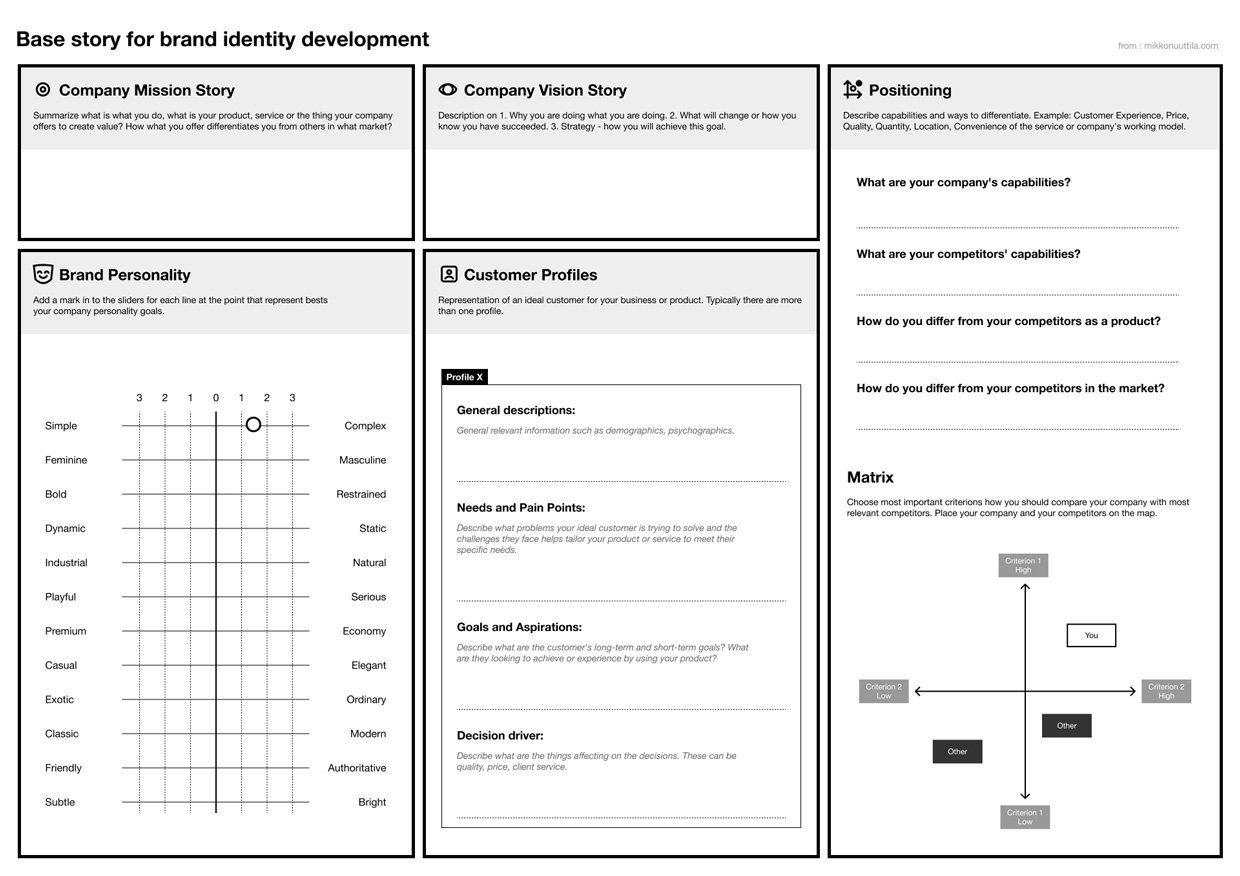How to start creating your new shiny brand identity? Don’t just dive into creating that incredibly cool logo for your company. Ensure your narrative is strong. Here are some thoughts how get started with first steps on development and design of brand identity.
What is Brand?
There exist multiple definitions for a brand. One of the most compelling ones comes from author Seth Godin: “A brand is a set of expectations, memories, stories, and relationships that, taken together, account for a consumer’s decision to choose one product or service over another.”
"A brand is a set of expectations, memories, stories, and relationships that, taken together, account for a consumer’s decision to choose one product or service over another."
In short, a brand can be seen as the sum of how a product or business is perceived by those who experience it.
What is Brand Identity then?
Brand identity is a guideline on how a company wishes to be portrayed to its customers. It encompasses the style and methods the company employs to differentiate itself, describe its values, or align with its business goals. Brand identity isn’t just visual styles such as your brand’s use of colours or its name and logo. Instead, it should offer a consistent definition for all sensory experiences the company creates for its customers—how your brand feels, looks, speaks, or even smells. Choose the most effective means to express your company’s brand.

So where to start? How do you define and build your brand identity?
To establish a robust and functional brand identity, you need a solid narrative that the identity can rely upon. For brand identity, this narrative is constructed around your company’s core principles and unique attributes.
Based on my own experience, you’ll need answers to at least the following questions to build that narrative.
Key questions to construct a coherent story for your brand identity:
- Story of Your Company’s Meaning (Story of Company Mission): Why does your company exist?
- Story of Where the Company is Headed (Story of Company Vision): What direction is your company taking? What are the business objectives that define your
- Understanding Your Customer Base (Customer profiles): Who are your company’s customers? Equally important, who are not your customers?
- Defining Your Company’s Purpose and Uniqueness (Brand Positioning): For whom does your company exist? How does it distinguish itself in the core market segment?
- What are your company’s human characteristics? (Brand Personality): Every brand should have traits like humans, something people can relate to and build emotional connection.
Start Defining Vision and Mission
In most cases, answers to these questions can be found within existing company strategies, statements, and definitions. If additional work is required for some of these, there are various methods and tools available to help uncover the answers to the questions listed above.
Let’s begin with the mission and vision. These two components are sometimes combined into a single definition, but they are intended to represent distinct concepts. The mission should focus on your company’s current activities, while the vision should articulate your aspirations for the future.
A well-summarized marketing-style statement is useful for conveying your vision and mission to various stakeholders. However, it may not provide the best foundation for developing a brand identity. Instead, the vision and mission statements should be unpacked into a narrative that is easily understood by individuals without an in-depth knowledge of the company’s history, cultural experiences, or practices. This approach ensures that the brand identity brief is clear and leaves minimal room for interpretation.
The story of a company’s mission should articulate what you do, the product or service you offer to create value, how you differentiate yourself from others, and ultimately, your target market. Who stands to benefit from what you offer?
Your company’s vision should outline where the company is headed in the future. It should also be specific enough to provide a clear indicator of when your vision has been achieved. However, it’s important to note that using revenue or a specified growth percentage as measures of success may not be motivating for the vision.
Vision stories can be divided into three key components: the purpose (why you do what you do), the envisioned changes or indicators of success, and the strategy detailing how you will attain your goals.
Brand identity relies on these two stories to grasp the core elements of your company and its future trajectory.
Positioning and Customer Profiles
Brand positioning involves strategically situating your company in the minds of your customers. For this reason, brand positioning is an invaluable resource to establish before embarking on the development of your brand identity.
Key to successful brand positioning is understanding the field you are competing in. You must grasp who your customers are and what they desire. Deeply understanding your company’s capabilities is essential to identifying the right differentiation strategy. Additionally, thorough competitor mapping is crucial. Relying solely on your own opinions of other companies is insufficient; research thoroughly to avoid blind spots. Where do these companies position their brand? With a comprehensive grasp of your company’s features and its relevant competitors, you can plot them on the same map. What does the landscape look like? Is the competition fierce? Is there a distinct sweet spot you aim to target?
Brand identity won’t hit the target without precise customer or target group specifications. Brand identity cannot succeed without precise customer or target group specifications. The customer profile must define the ideal customer for your business. Using short descriptions, clearly define your ideal customer – Your ideal customer, encompassing their requirements, motivations, and influencing factors or decision drivers. These profiles apply not just to product marketing, but also extend to areas like recruitment as well.
To find your brand positioning you can start by answering these questions:
- What are your company’s capabilities?
- What are your competitors’ capabilities?
- How do you differ from your competitors as a product?
- How do you differ from your competitors in the market?
- Is that differentiation relevant to your customers?
Company capabilities can be for example: Customer Experience, Price, Quality, Quantity, Location, Convenience of the service or company’s working model.
Move to personality
Based on my experience, Brand Personality often serves as the most direct connection when transforming your company’s traits and attributes into a style that conveys your story. Numerous methods can aid in identifying your brand’s human-like characteristics, and two of my preferred approaches are as follows:
1. Comparison: Align valuable characteristics side by side and assess how your brand strikes a balance between them. For instance, consider whether your brand leans more toward emotional or functional, or if it embodies minimalism or opulence.
2. Analogy: Draw parallels to well-known real-life or fictional characters. Select from a pre-made list of personalities that either align with or counter your brand’s essence. Each choice should come with a clear explanation for its selection. The latter method is particularly effective for swiftly identifying human-like traits your brand seeks to express.
Company capabilities can be for example: Customer Experience, Price, Quality, Quantity, Location, Convenience of the service or company’s working model.
Next steps:
What should you do with these distinct definitions? Consolidate all this knowledge into a unified format. This document can serve as a brief for your brand identity, anchoring it on essential components. The actual design of your brand identity commences here, guided by the content outlined in this post.
To assist in collating these diverse definitions, here’s a template that may prove beneficial. Feel free to customize it according to your requirements, providing a solid starting point for your brand identity project.
 download the template
download the template